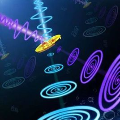With the advent of Web 3.0, the swift advancement of technology confronts an imminent threat from quantum computing. Security protocols safeguarding the integrity of Web 2.0 and Web 3.0 are growing more susceptible to both quantum attacks and sophisticated classical threats. The article introduces our novel long-distance free-space quantum secure direct communication (LF QSDC) as a method to safeguard against security breaches in both quantum and classical contexts. Differing from techniques like quantum key distribution (QKD), LF QSDC surpasses constraints by facilitating encrypted data transmission sans key exchanges, thus diminishing the inherent weaknesses of key-based systems. The distinctiveness of this attribute, coupled with its quantum mechanics base, protects against quantum computer assaults and advanced non-quantum dangers, harmonizing seamlessly with the untrustworthy tenets of the Web 3.0 age. The focus of our study is the technical design and incorporation of LF QSDC into web 3.0 network infrastructures, highlighting its efficacy for extended-range communication. LF QSDC is based on the memory DL04 protocol and enhanced with our novel Quantum-Aware Low-Density Parity Check (LDPC), Pointing, Acquisition, and Tracking (PAT) technologies, and Atmospheric Quantum Correction Algorithm (AQCA). Utilizing this method not only bolsters the security of worldwide Web 3.0 networks but also guarantees their endurance in a time when quantum and sophisticated classical threats exist simultaneously. Consequently, LF QSDC stands out as a robust security solution, well-suited for Web 3.0 systems amidst the constantly evolving digital environment.
翻译:暂无翻译



